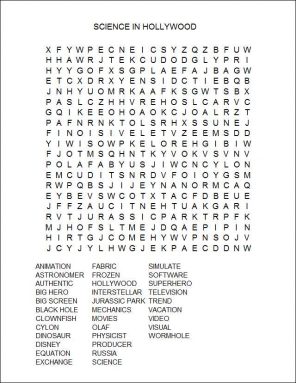Science in Hollywood
Make-believe movies, TV shows and video games increasingly star the work of real scientists
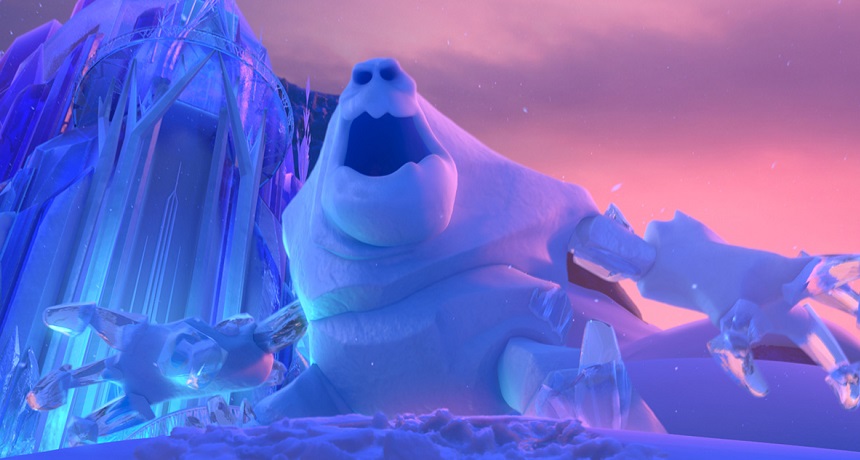
To make realistic-looking snow, the filmmakers behind Frozen asked mathematicians for help.
Image: © The Walt Disney Co.
There’s so much snow in the movie Frozen that the cold white stuff might as well be the star of the animated film. It falls, flies, piles and melts. Snow sprays through the air as Anna and Kristoff cling to a reindeer-pulled sleigh, barely escaping a pack of snarling wolves. Snow dances in the air as Elsa uses her special powers to build an icy fortress on a lonely mountain. The movie even includes Olaf, a wisecracking snowman.
Knowing that snow would play such an important role, the filmmakers at Walt Disney Animation Studios wanted to be sure they got it right. So they turned to Joseph Teran. He is a mathematician at the University of California, Los Angeles. Teran uses computers to model natural phenomena. Teran has worked on many animated films for Disney, but Frozen posed a new challenge.
No animated movie before had needed snow to do so many things, he says. Snow can flow like a liquid — or stick together like a solid. For months, he and his team used mathematical equations and computer software to create some of the most realistic animated snow ever to fall on the Big Screen.
In the world of Hollywood blockbusters, the science that went into making Frozen is becoming the new normal. More and more, makers of films, television shows and even video games are enlisting the help of scientists to bring more dazzle — and accuracy — to theater, television and computer screens across the planet.
The science in sci-fi
Scientists have consulted on the superhero flick The Avengers, the sci-fi hit Interstellar and TV shows such as The Big Bang Theory and Marvel’s Agents of S.H.I.E.L.D. The director of Thor brought in an expert physicist to help hammer out a plausible explanation for how the movie’s hero travels so quickly across space. Scientists guide the creation of real-looking special effects. They can help make a story more accurate. And sometimes, their research even inspires the stories that end up on the Big Screen.
Improved access to real expertise has encouraged Hollywood to give science a bigger role. Since 2008, the Science and Entertainment Exchange has helped that happen by connecting scientists and filmmakers. The Exchange, based in Los Angeles, Calif., is part of the National Academy of Sciences. This nonprofit organization provides scientific expertise to the public.
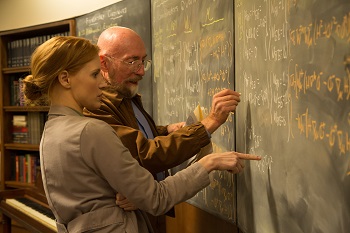
“Each year since we started the Exchange, the number of consults we’ve done on film and TV projects has increased,” says Rick Loverd, the group’s director. In fact, the Exchange recently celebrated its thousandth match.
There is more science in Hollywood because moviegoers demand it. “Audiences are getting smarter,” explains David Kirby. He trained as a geneticist but now studies the link between science and film at the University of Manchester in the United Kingdom. He’s even written a book about it, called Lab Coats in Hollywood (MIT Press: Cambridge, Mass., 2011).
Kirby says that after more than a century of moviemaking, people are “becoming better at being an audience.” They can tell what looks real and what looks fake. And audiences definitely want their films to look and feel authentic.
Or, as Loverd says, a movie has to pass the audience’s “smell test.” If the movie stinks, it bombs.
View to a black hole
The science fiction author Arthur C. Clarke famously wrote that “any sufficiently advanced technology is indistinguishable from magic.” While he wasn’t writing specifically about making movies, his statement applies. Filmmakers use advanced technology and advice to create magic onscreen.
The movie Interstellar takes place in the near future. Things are dismal. Earth is dying. Looking for a new home planet, a crew of astronauts blasts off. They travel through a wormhole. It is like a space tunnel that leads them to a distant planetary neighborhood. During their adventure, the astronauts also zip close to a black hole called Gargantuan.
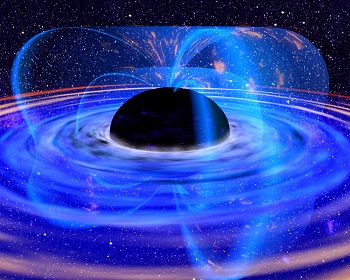
Astronomers have never seen wormholes, although scientists predicted the existence of these tunnels as early as 1916. Kip Thorne, a physicist at the California Institute of Technology in Pasadena, has studied them for decades. Not surprisingly, Thorne was closely involved with the making of
Interstellar.
In 2005, Lynda Obst — a former girlfriend and current Hollywood producer — told him about her idea for a movie about astronauts traveling by a wormhole. (This would be Obst’s second movie involving the space tunnels. She also worked on
Contact
. In that 1997 film, the character played by Jodie Foster encounters alien civilizations after traveling through multiple wormholes.)
Thorne loved the idea. For months, he and Obst swapped ideas over dinners, e-mails and phone calls. Most important to him, however, was the idea of a movie “grounded from the outset in real science,” he writes in his book: The Science of Interstellar. He wanted the filmmakers to respect the science “and weave it into the movie’s fabric.” Thorne’s vision was that audiences would get an idea of the amazing things that might exist in the universe. And all of what they encountered on screen would respect the laws of physics.
Thorne wasn’t the only scientist involved in the movie. Graduate students at the University of California, Los Angeles, created one video that showed what a person might see near a black hole. A black hole is a tiny place in space packed with matter. Its gravitational pull is so strong that nothing — or almost nothing — can escape it. Another video showed how a black hole’s pull can bend light that’s traveling nearby. Thorne showed the videos to Interstellar’s special effects team. Those experts relied on those videos when creating their visuals for the movie.
COMING TOGETHER Here’s a video depicting the collision — or merging — of two black holes. SXSCollaboration |
Kirby, the University of Manchester scientist and author, says filmmakers have been consulting with scientists throughout movie history. “That surprises people,” he says. Early on, though, such meetings were unusual. Then everything changed. Kirby calls the current (and growing) use of scientists in movies a “post-Jurassic Park phenomenon.”
The motion in motion pictures
Jurassic Park came out in 1993. The movie takes place on an island where a scientist has found a way to clone dinosaurs. Things don’t go well. To make the movie, director Steven Spielberg consulted with Jack Horner, a paleontologist. Horner helped the filmmakers design real-looking dinosaurs for the screen. He even inspired one of the characters. The film wasn’t entirely accurate — dinosaurs are still extinct — but the illusion worked. The movie was a spectacular success, in large part because it looked so real, says Kirby.
Since then, Kirby says, scientific accuracy has become even more important. “The development of special effects now means that audiences expect realism in everything,” he says.
Teran says part of that is getting the physics right. Physicists study matter and energy. They also study mechanics. Mechanics refers to motion and the forces that produce it. And if something doesn’t move right on the screen, Teran says, an audience can tell. “If the physics is wrong, the movie looks less real.”
Take snow: In the past, films didn’t pay much attention to the white stuff, says Teran. That changed with Frozen. To get the snow to look realistic, he and his team borrowed a mathematical approach called the “material point method.” Using this method meant the mathematicians treated big blobs of snow as being made of lots of little particles. Sometimes the particles stuck together and sometimes they fell apart — like when a packed snowball smashes against a wall.
SNOW SIMULATION This video shows how the Walt Disney studios developed snow using their “material point method.” Walt Disney Animation Studios |
The researchers spent months creating a computer program that would simulate snow in such a way that it behaved like real snow. And that was a challenge: In the movie, characters dig in snow, walk through snow and fall in the snow. Snowballs stick together like a solid, but disintegrate under stress. Tweaking their program to cover all these behaviors required some creative programming. The scientists couldn’t make the computer program too complicated — it had to be able to compute real snow in a short amount of time. To make matters worse, at a certain point Teran became convinced that his team was missing the mark.
“I didn’t think it looked right,” he said. One of his students, who was from Russia, insisted that the snow did look real. While on vacation, the student went to the mountains and shot video of real snow in action. He showed the video to Teran. Upon comparing real snow to their computer model, Teran finally admitted that their computer program had succeeded. “Our snowballs looked pretty real.”
It’s not just film that gets developed in the lab…
Special effects aren’t the only area in which scientists work on films. Screenwriters and producers are also looking to researchers — and their findings — for ideas, including how to spin a better story. Kirby points to Finding Nemo. This 2003 animated movie is about a talking clownfish searching for his missing son.
“It’s one of my favorite examples of a scientifically accurate film,” says Kirby, referring to the realism of the undersea habitats created onscreen. “The filmmakers did a lot of research and talked to a lot of scientists to make sure that film was as accurate as possible. Outside of having the fish talk, of course.”
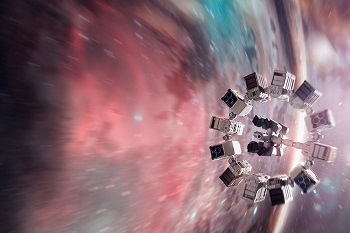
And just as scientists inspire movies, the opposite is true as well, says Loverd, at the Science and Entertainment Exchange.
Walk through any scientific lab and the odds are high that you’ll see a picture of Star Trek’s Spock, a Cylon from Battlestar Galactica or perhaps a superhero, Loverd says. “These characters have inspired scientists.”
He explains how the Exchange hosts events such as talks and retreats to give scientists and filmmakers a way to share ideas. As a result, he says, producers may “leave our events with new ideas for films and TV shows, or make big changes to the project they’re working on.” Loverd notes that the system isn’t perfect. A movie still may tweak the science if it makes the story better, after all.
Now casting: STEM experts
Many movies — not just animated ones — use computer simulations to create special effects.
“Clothing, skin, snow, water, smoke, fire — all kinds of things” are modeled with computers, Teran says. Creating real-looking effects “requires a ton of math and a ton of physics,” he says. Studying a STEM subject may seem like an unusual way to get involved with movies. However, Teran says Hollywood is showing strong demand for experts who studied math or science in college. Their help is needed, and will continue to be needed, in creating ever more sophisticated effects.
“Look at Shrek, a movie from 10 years ago,” Teran says. “At the time, I thought it looked amazing. But I watch it now, and it looks worse than video games. So video games already look more realistic than older movies.”
That trend isn’t going to change. He worked on the animation in last year’s Big Hero 6. And he’s already hard at work on Disney movies coming out this year and next — though he’s not allowed to talk about them just yet. All he can say is that the movies will require even more complicated calculations than Frozen did. Eventually, animation will become indistinguishable from live action.
“The people will look like real people,” he says. “You won’t be able to tell the difference.”
Power Words
(for more about Power Words, click here)
black hole A region of space having a gravitational field so intense that no matter nor radiation (including light) can escape.
computer model A program that runs on a computer that creates a model, or simulation, of a real-world feature, phenomenon or event.
computer program A set of instructions that a computer uses to perform some analysis or computation. The writing of these instructions is known as computer programming.
equation In mathematics, the statement that two quantities are equal. In geometry, equations are often used to determine the shape of a curve or surface.
gravity The force that attracts anything with mass, or bulk, toward any other thing with mass. The more mass that something has, the greater its gravity.
habitat The area or natural environment in which an animal or plant normally lives, such as a desert, coral reef or freshwater lake. A habitat can be home to thousands of different species.
Jurassic Lasting from about 200 million to 145.5 million years ago, it’s the middle period of the Mesozoic Era. This was a time when dinosaurs were the dominant form of life on land.
mechanics The study of how things move.
model A simulation of a real-world event (usually using a computer) that has been developed to predict one or more likely outcomes.
paleontologist A scientist who specializes in studying fossils, the remains of ancient organisms.
particle A minute amount of something.
phenomenon Something that is surprising or unusual.
physicist A scientist who studies the nature and properties of matter and energy.
physics The scientific study of the nature and properties of matter and energy. (Classical physics) An explanation of the nature and properties of matter and energy that relies on descriptions such as Newton’s laws of motion. It’s an alternative to quantum physics in explaining the motions and behavior of matter.
software The mathematical instructions that direct a computer’s hardware, including its processor, to perform certain operations.
wormhole Tunnels or bridges that allow objects to take a shortcut between two distant places in space and time. Although none has yet been witnessed, Einstein’s general theory of relativity predicted their physics and possible existence.
Word Find (click here to enlarge for printing)
